5 Great Reasons to Grow Turk’s Cap: A Native Shade Plant
Today I’m talking all about Turk’s Cap (Malvaviscus arboreus) – a plant native to my state of Texas! If you’re a flower gardener, you know that one of our chief struggles is finding plants that will flower in the shade.
Here in Texas, we have the dual challenge of finding plants that will do well in the shade, but also withstand staggering temps and drought conditions in late summer. Turk’s Cap satisfies both of these needs while being very easy to care for.
Looking for more shade-loving plants like Turks Cap? Start by downloading my free printable PDF of the Top 10 Texas Shade Plants. You can take this handy one-pager with you to the plant nursery.
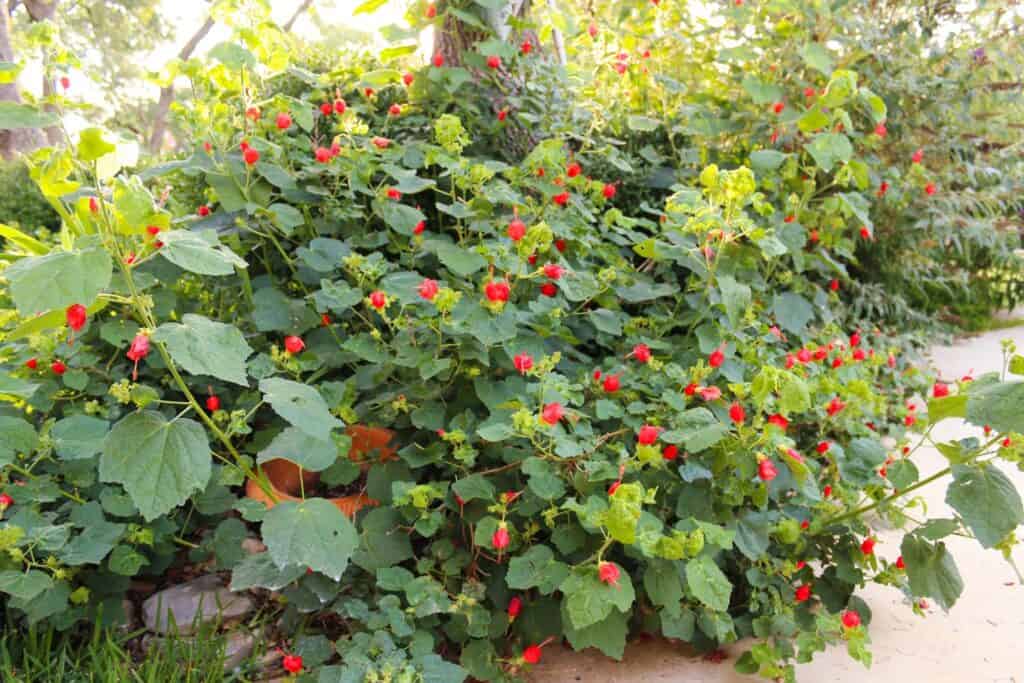
5 Reasons to Grow Turk’s Cap
We have three plants growing in a shady corner of our backyard. I consider Turk’s Cap a great intro plant for someone beginning native plant gardening because it is so easy to grow. It is one of my favorite Texas natives. Here are some reasons to add it to your yard:
1. Provides reliable flowers from late spring through fall
Turk’s Cap has a long bloom period. It starts blooming in May and doesn’t stop until November! In Texas in the heat of summer it can be hard to find a plant that wants to bloom, but Turk’s Cap will do so happily.
2. One of the few plants that blooms prolifically in part shade
Many of us have trees in our yards creating shady conditions in many areas. This is a good choice to grow in part sun or partial shade flower beds if you want a pop of color.
3. Grows well in a variety of sunlight conditions
While Turk’s Cap likes some shade, I’ve even seen it planted in full sun here in Texas and still doing well. It will likely just require more regular watering if you plant it in full sun.
4. Provides food for pollinators and wildlife
When I pick a new plant to put in my yard one of my top criteria now is whether it offers wildlife benefits, and the this plant has several. The Turk’s Cap flowers attract hummingbirds and pollinators throughout its blooming period.
It also produces a small red fruit that can be eaten by birds and other wildlife. Even humans can eat them! It is known to taste like an apple, hence the Spanish name “manzanita” (little apple) being one of its common names.
5. It is a butterfly host plant!
Finally, we need more butterfly and moth host plants in our yards to help support those populations. Because without caterpillars we won’t have birds! You can read more about why this is so important in my Top 6 Benefits of Native Plants.
The good news is that Turk’s Cap is the host plant for the Turk’s Cap White Skipper butterfly.
According to butterfliesandmoths.org, the females lay their eggs on the twigs and buds of the host plant. Then the baby caterpillars feed on the plant’s leaves, flowers and fruit. So by having the plant in your yard you are providing an important habitat and food source!
Download the Free PDF: Texas Native Shade Plants
Have a shady yard? I created a handy one-page PDF for you to print and take along with you to the plant nursery. It includes a thumbnail photo of each plant along with both its common and scientific name, shade requirements, and other helpful growing info. Get it here:

Where is Turks Cap Native to?
According to Wildflower.org, Turk’s Cap is a native shrub in various states in the Southeastern U.S. There are different varieties of Malvaviscus arboreus that are native all the way down through South America. Here are the states where it is native:
- Alabama
- Arkansas
- Florida
- Georgia
- Louisiana
- Mississippi
- Texas
What does the Turk’s Cap flower look like?
Turks Cap has bright red hibiscus flowers. These tightly twisted blooms never fully open, and resemble a Turkish turban or fez -giving them the common name Turk’s Cap!
I love seeing the ruby throated hummingbirds visit my yard to drink from the flowers. Hopefully one day I’ll be able to capture a photo of them in action!
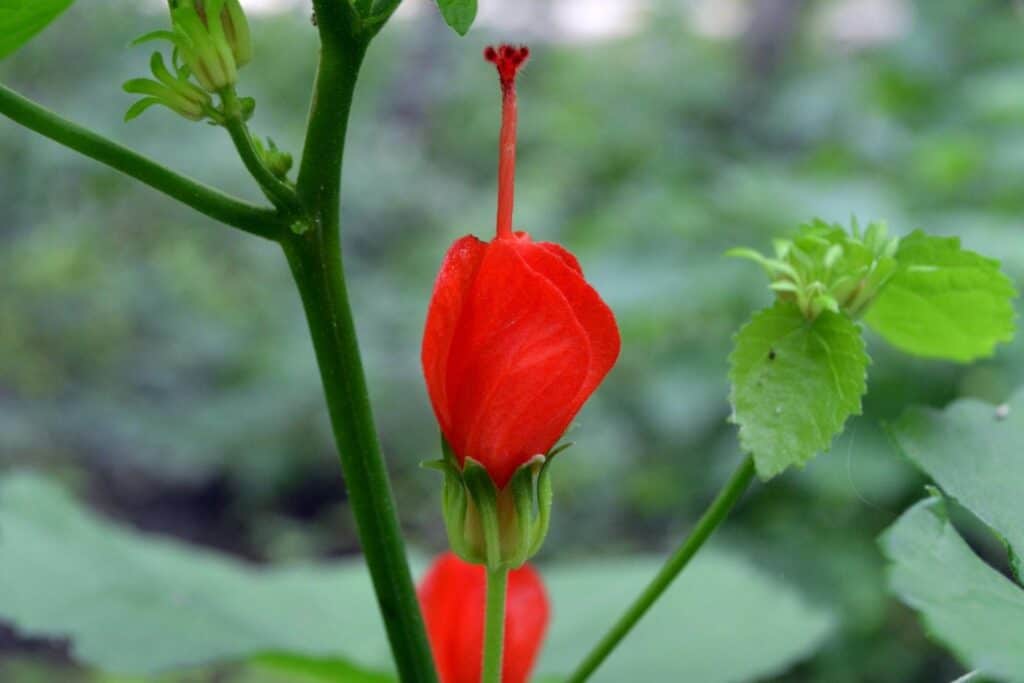
What is the scientific name for Turks Cap?
Plant names can be tricky, because one plant often has many aliases! That is why using their scientific name is so helpful because each plant has only one scientific name, but can have many common names.
The scientific name of the Turk’s Cap I’m referring to is Malvaviscus arboreus (var. drummondii).
Just a heads up that there is another plant called Turk’s Cap that is Malvaviscus penduliflorus. It is native to Mexico and looks similar to Malvavisus arboreus except that its flowers hang down.
What are common names for Turk’s Cap?
According to Wildflower.org other common names for Turk’s Cap include Wax Mallow, Mexican Apple, Sleeping Hibiscus, Bleeding Hearts, and Manzanita among others.
Another completely different plant goes by the common name Turk’s Cap. However this plant is a lily (Lilium superbum). Talk about confusing! Pro tip: write down the scientific name (Malvaviscus arboreus) to avoid confusion at the nursery.
Turk’s Cap Plant Care Tips
As I’ve mentioned this is one easy plant to grow! It will grow in a variety of soil types and can handle dry soil or moist soil Once the plant is established you do not need to water it very often. I give our plants a weekly watering during the summer, and less frequently the rest of the year.
If your Turks Cap gets leggy you can prune it back by 1/3 to 1/2. It typically dies back in the winter once the cold temperatures hit, so I always cut it back to about 6 inches above the ground before the spring. If you don’t mind leaving the dead foliage up in the winter, it can provide shelter for birds and other little creatures!
Turk’s Cap Propagation
You can propagate Turk’s Cap from softwood cuttings or by digging up new plants and transplanting them.
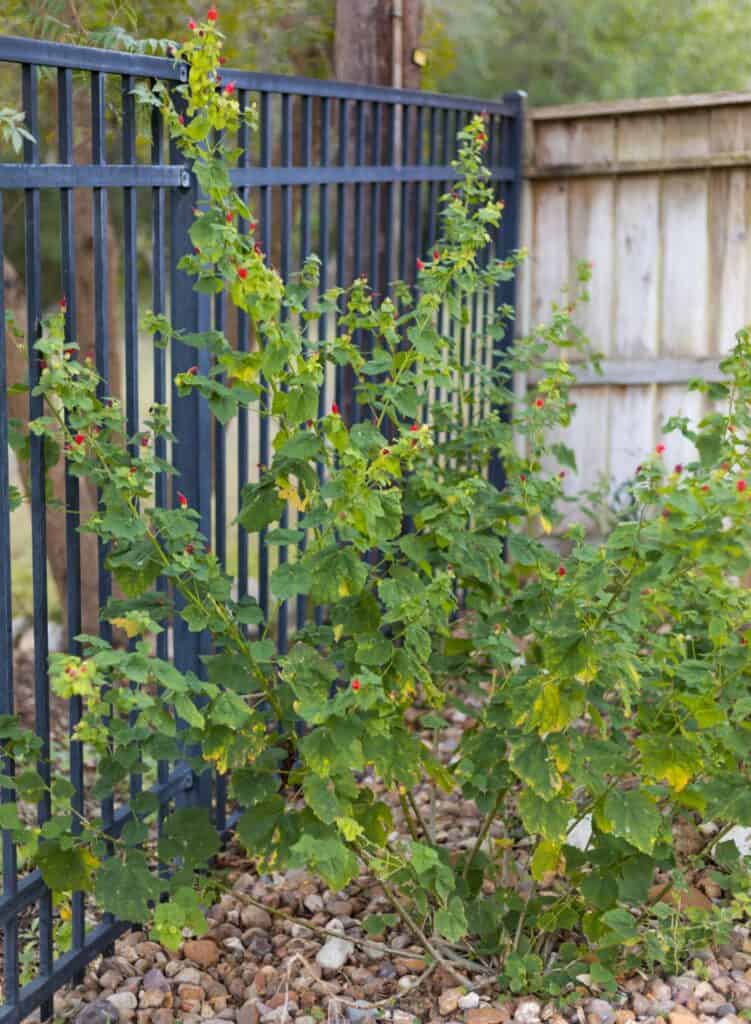
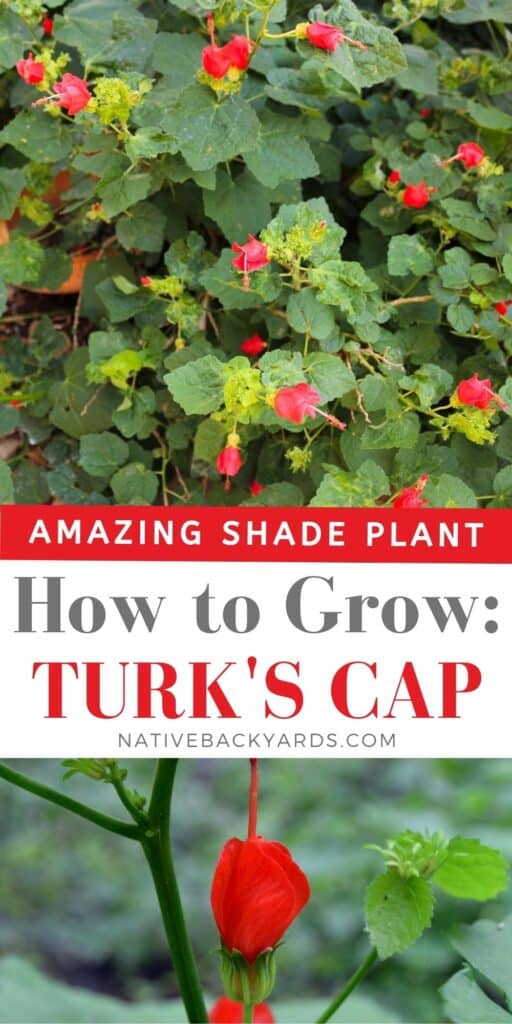
Want to find more native plants in your area?
Check out our top tips:
Turk's Cap Plant Care Printable
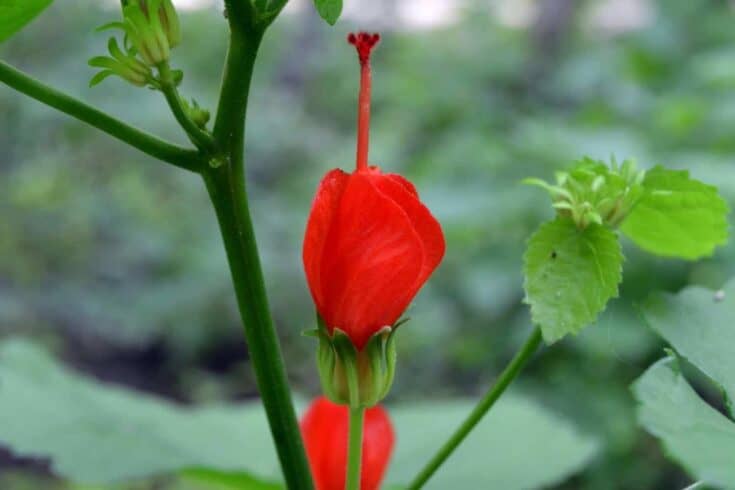
Malvaviscus arboreus (var. drummondii)
Native to:Alabama, Arkansas, Florida, Georgia, Louisiana, Mississippi. Texas
Mature Height and Width:3-6' tall / 3-5' wide
Sun Conditions:Full shade to full sun. Tolerates a variety of conditions but performs best with some shade.
Water Needs:Low water once established. Can withstand hot summer temps with weekly watering.
Wildlife Benefits:Great nectar source for hummingbirds and other pollinators. Blooms last from May through November. Host plant for the Turk's Cap White Skipper butterfly.
Materials
Instructions
Watering
- Low water needs once established.
- Can tolerate drought conditions and hot temps.
Pruning
- Prune back plant in winter if it gets too leggy.
- Leave about six inches of the stems remaining above ground.
Propagating
- Plant can be propagated in spring by soft wood cuttings, or by root separation. Water throughly once transplanted.
Notes
Turk's Cap is a great entry level plant if you are looking to add more native plants to your yard. It performs well in a variety of conditions and its prolific blooms attract hummingbirds and pollinators.
Recommended Products
As an Amazon Associate and member of other affiliate programs, I earn from qualifying purchases.
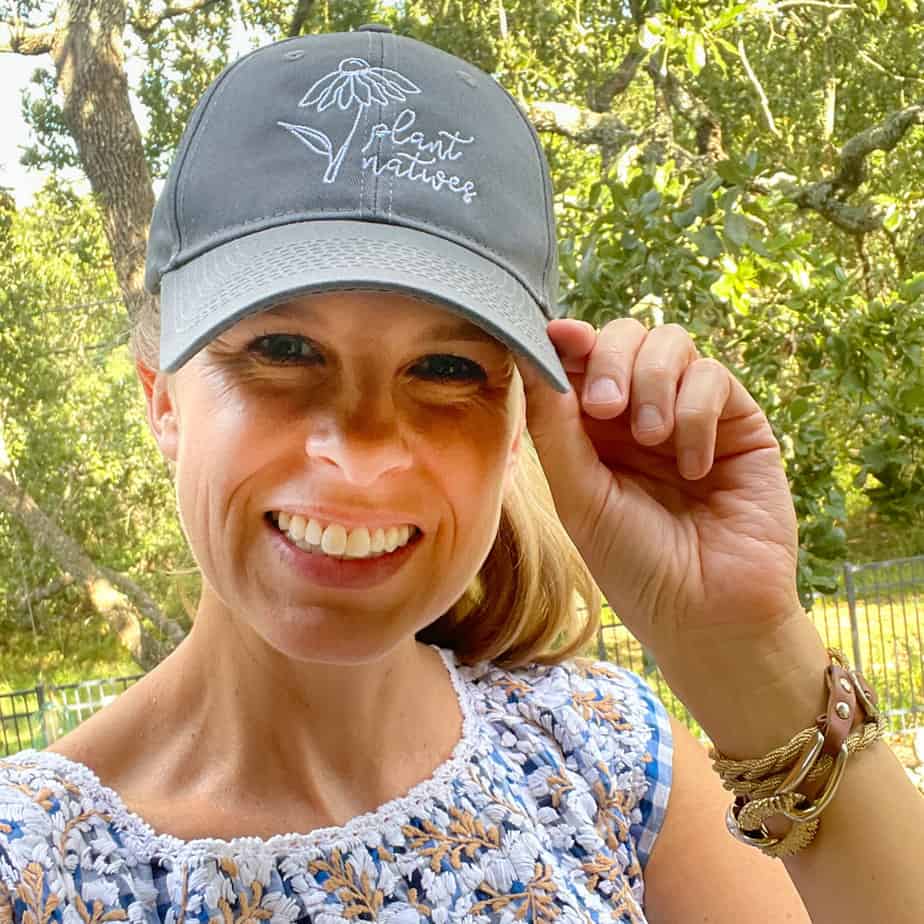
Welcome to Native Backyards! I’m Haeley from San Antonio, Texas, and I want to help you grow more native plants.
I have seen firsthand how the right plants can bring your yard to life with butterflies, bees, and birds. I’ve transformed my yard with Texas natives and I’m excited to share what I’ve learned with you.
Join my newsletter here! – each week I’ll send you helpful tips to make your native plant garden a reality!
Want to learn more about me and my garden? Check out my About page!



Thank you for helping me identify this plant. I’m in Tennessee and Turk’s Cap isn’t a native plant here but I was offered a cutting last Summer from a mature bush and not only did it grow roots but has now added additional leaves and a flower bud. It’s still in water and I’m scared to traumatize it by planting it in soil now. Soon as the weather turns to Spring, I have a spot for it outdoors. Your information has been very helpful and I hope to have my own bush later this year.
Paula, that is great that you have been able to root it from a cutting! I have had success rooting Turk’s Cap using cuttings dipped in Rooting Hormone and then put straight into a pot with soil. They are pretty hardy! I hope it grows well for you!
I have a septic field section that is near my house foundation and is part to full shade on the north side of the house. I am having trouble keeping the grass alive in that area, and am thinking of planting Turks Cap there. Are their companion plants that you would recommend in the bed with the Turks Cap? I was thinking of Maidenhair fern and maybe some shade Merigolds? Any suggestions are welcome. The soil is moist in this area.
I also have a section of flowerbeds nearby (about 15 ft or more away) that attract Monarch Butterflies, bees, and all kinds of insects to Mist Flower, Lantana, Pink Skull Cap, and knock out roses and other fun sun loving plants.
Hi Sheri! Thanks for your comment. I really like Inland Sea Oats with Turks Cap. Frostweed is a great Monarch plant that thrives in shade – its fall blooms provide nectar to the migrating monarchs. Not sure where you are located, but here are some of my favorite Texas Native Shade plants that could work: https://nativebackyards.com/texas-shade-plants/
I’m pleased to have found you!! Purely by accident but lucky.
Hv good bit of property west and south of Hamilton. We’re about 1800 ‘ in elevation in a valley surrounded by huge am elms. I’m putting in a small underscored entrance with a custom made wood sign on a cedar post surrounded by a split rail fence. It’s rather shady in the afternoon surrounded by mature pecan trees. Want to design a rustic plant gatherin’ and thought about some desert plant taller than the sign entrance. I like your suggestion of Turk’s and a whips of sea oats (possibly). Size is 20 X 30. I’m having a tough time with designers who want to put urban growth on a ranch entrance. Do you have a suggestion where to find someone who knows or cares about such a project. BTW this property is a small valley, very little rocks and has abundant grass. Water is abundant in well and tank. (We in central and west Texas call a body of water a tank instead of a pond for you folks not familiar w/ Tx talk)which is several yards away for the time being. Several people hv seen this land and some friends in the advertsising trade want to use it as a back drop for shooting stuff. Now comes the butterin’ up stage, can you help improve on my ideas.
Oh, on the north end of this piece surrounded by trees which are better than 40′ tall I will plant Mission Olive trees. (north wind protection)Can you see the diversity along with common sense of what works in this horrible heat? Thank you!!
Sounds like you need to find a landscape designer/company who specializes in native landscaping. They are out there. Good luck!
I have a plant like this that my neighbor gave me, he called it an Upside Down Umbrella plant
That is a cute name, Diana! I’ve never heard it called that before. 😊
Is Turks cap safe for children and pets?
Yes it is. The Texas native turks cap (Malvaviscus arboreus var. drummondii) is not toxic. In fact, you can eat the little fruits it produces. They taste like a little apple or pear!
Have a good size one about 15-20 yrs old, can they be dug up split up, and replanted and by how much of a%
They can be dug up, but I have never tried transplanting such a mature Turks’ Cap. They typically put off “baby” plants and I have dug up and transplanted those successfully. Even those small plants have quite the long roots on them, so I imagine a 15 year old plant would be tricky to dig up given its root system!
Thank you for this information. I have a Turks cap in my backyard but the flowers are white. Everything I have seen about Turks cap the flowers are red.
Hi Janne, there is a white version of Turk’s Cap too, and a pink cultivar as well. Here is some more information on the white Turks Cap: https://www.penick.net/digging/?p=23073
I planted a Turks Cap in 1995. Then in 2009 we ripped everything out and re-designed and landscaped the backyard. Last year (14 yrs later) I saw a sprout on my neighbor’s side of the wrought iron fence. This year it is full size and coming thru the fence into my beds (at the same original location)! I think I’ll leave it! Thx for the encouragement!
I have a Turks cap under live oak in part shade and it stopped flowering this summer and last but otherwise healthy.
Is there particular fertilizer that would help?
Hi Lori, I don’t usually recommend fertilizer for native plants, but you could add a layer of compost around the base or sprinkle some organic soil conditioner around the base and water in: https://foxfarm.com/product/happy-frog-soil-conditioner